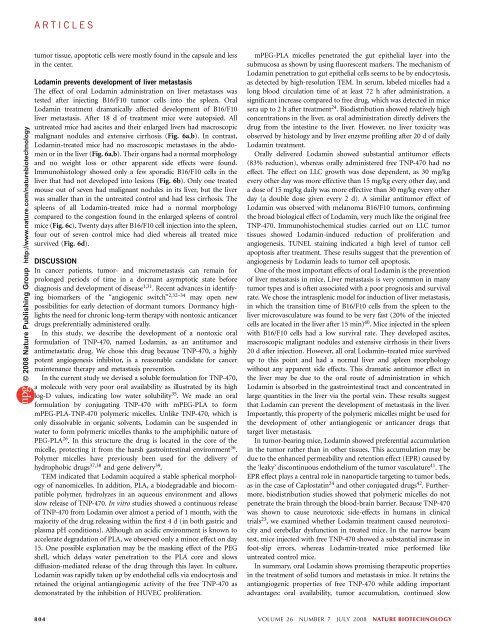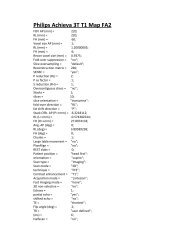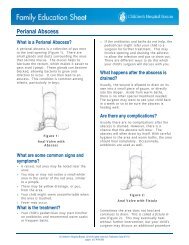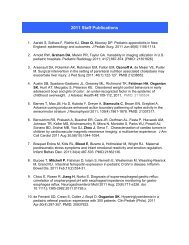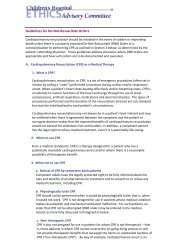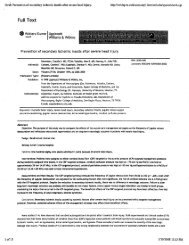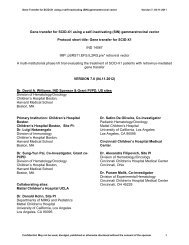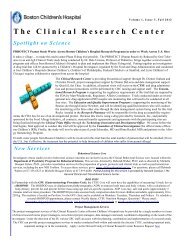PDF version - Children's Hospital Boston
PDF version - Children's Hospital Boston
PDF version - Children's Hospital Boston
You also want an ePaper? Increase the reach of your titles
YUMPU automatically turns print PDFs into web optimized ePapers that Google loves.
© 2008 Nature Publishing Group http://www.nature.com/naturebiotechnology<br />
ARTICLES<br />
tumor tissue, apoptotic cells were mostly found in the capsule and less<br />
in the center.<br />
Lodamin prevents development of liver metastasis<br />
The effect of oral Lodamin administration on liver metastases was<br />
tested after injecting B16/F10 tumor cells into the spleen. Oral<br />
Lodamin treatment dramatically affected development of B16/F10<br />
liver metastasis. After 18 d of treatment mice were autopsied. All<br />
untreated mice had ascites and their enlarged livers had macroscopic<br />
malignant nodules and extensive cirrhosis (Fig. 6a,b). In contrast,<br />
Lodamin-treated mice had no macroscopic metastases in the abdomen<br />
or in the liver (Fig. 6a,b). Their organs had a normal morphology<br />
and no weight loss or other apparent side effects were found.<br />
Immunohistology showed only a few sporadic B16/F10 cells in the<br />
liver that had not developed into lesions (Fig. 6b). Only one treated<br />
mouse out of seven had malignant nodules in its liver, but the liver<br />
was smaller than in the untreated control and had less cirrhosis. The<br />
spleens of all Lodamin-treated mice had a normal morphology<br />
compared to the congestion found in the enlarged spleens of control<br />
mice (Fig. 6c). Twenty days after B16/F10 cell injection into the spleen,<br />
four out of seven control mice had died whereas all treated mice<br />
survived (Fig. 6d).<br />
DISCUSSION<br />
In cancer patients, tumor- and micrometastasis can remain for<br />
prolonged periods of time in a dormant asymptotic state before<br />
diagnosis and development of disease 1,31 . Recent advances in identifying<br />
biomarkers of the ‘‘angiogenic switch’’ 2,32–34 may open new<br />
possibilities for early detection of dormant tumors. Dormancy highlights<br />
the need for chronic long-term therapy with nontoxic anticancer<br />
drugs preferentially administered orally.<br />
In this study, we describe the development of a nontoxic oral<br />
formulation of TNP-470, named Lodamin, as an antitumor and<br />
antimetastatic drug. We chose this drug because TNP-470, a highly<br />
potent angiogenesis inhibitor, is a reasonable candidate for cancer<br />
maintenance therapy and metastasis prevention.<br />
In the current study we devised a soluble formulation for TNP-470,<br />
a molecule with very poor oral availability as illustrated by its high<br />
log-D values, indicating low water solubility 35 . We made an oral<br />
formulation by conjugating TNP-470 with mPEG-PLA to form<br />
mPEG-PLA-TNP-470 polymeric micelles. Unlike TNP-470, which is<br />
only dissolvable in organic solvents, Lodamin can be suspended in<br />
water to form polymeric micelles thanks to the amphiphilic nature of<br />
PEG-PLA 26 .Inthisstructurethedrugislocatedinthecoreofthe<br />
micelle, protecting it from the harsh gastrointestinal environment 36 .<br />
Polymer micelles have previously been used for the delivery of<br />
hydrophobic drugs 37,38 and gene delivery 39 .<br />
TEM indicated that Lodamin acquired a stable spherical morphology<br />
of nanomicelles. In addition, PLA, a biodegradable and biocompatible<br />
polymer, hydrolyzes in an aqueous environment and allows<br />
slow release of TNP-470. In vitro studiesshowedacontinuousrelease<br />
of TNP-470 from Lodamin over almost a period of 1 month, with the<br />
majority of the drug releasing within the first 4 d (in both gastric and<br />
plasma pH conditions). Although an acidic environment is known to<br />
accelerate degradation of PLA, we observed only a minor effect on day<br />
15. One possible explanation may be the masking effect of the PEG<br />
shell, which delays water penetration to the PLA core and slows<br />
diffusion-mediated release of the drug through this layer. In culture,<br />
Lodamin was rapidly taken up by endothelial cells via endocytosis and<br />
retained the original antiangiogenic activity of the free TNP-470 as<br />
demonstrated by the inhibition of HUVEC proliferation.<br />
mPEG-PLA micelles penetrated the gut epithelial layer into the<br />
submucosa as shown by using fluorescent markers. The mechanism of<br />
Lodamin penetration to gut epithelial cells seems to be by endocytosis,<br />
as detected by high-resolution TEM. In serum, labeled micelles had a<br />
long blood circulation time of at least 72 h after administration, a<br />
significant increase compared to free drug, which was detected in mice<br />
sera up to 2 h after treatment 24 . Biodistribution showed relatively high<br />
concentrations in the liver, as oral administration directly delivers the<br />
drug from the intestine to the liver. However, no liver toxicity was<br />
observed by histology and by liver enzyme profiling after 20 d of daily<br />
Lodamin treatment.<br />
Orally delivered Lodamin showed substantial antitumor effects<br />
(83% reduction), whereas orally administered free TNP-470 had no<br />
effect. The effect on LLC growth was dose dependent, as 30 mg/kg<br />
every other day was more effective than 15 mg/kg every other day, and<br />
a dose of 15 mg/kg daily was more effective than 30 mg/kg every other<br />
day (a double dose given every 2 d). A similar antitumor effect of<br />
Lodamin was observed with melanoma B16/F10 tumors, confirming<br />
the broad biological effect of Lodamin, very much like the original free<br />
TNP-470. Immunohistochemical studies carried out on LLC tumor<br />
tissues showed Lodamin-induced reduction of proliferation and<br />
angiogenesis. TUNEL staining indicated a high level of tumor cell<br />
apoptosis after treatment. These results suggest that the prevention of<br />
angiogenesis by Lodamin leads to tumor cell apoptosis.<br />
One of the most important effects of oral Lodamin is the prevention<br />
of liver metastasis in mice. Liver metastasis is very common in many<br />
tumor types and is often associated with a poor prognosis and survival<br />
rate. We chose the intrasplenic model for induction of liver metastasis,<br />
in which the transition time of B16/F10 cells from the spleen to the<br />
liver microvasculature was found to be very fast (20% of the injected<br />
cells are located in the liver after 15 min) 40 . Mice injected in the spleen<br />
with B16/F10 cells had a low survival rate. They developed ascites,<br />
macroscopic malignant nodules and extensive cirrhosis in their livers<br />
20 d after injection. However, all oral Lodamin–treated mice survived<br />
up to this point and had a normal liver and spleen morphology<br />
without any apparent side effects. This dramatic antitumor effect in<br />
the liver may be due to the oral route of administration in which<br />
Lodamin is absorbed in the gastrointestinal tract and concentrated in<br />
large quantities in the liver via the portal vein. These results suggest<br />
that Lodamin can prevent the development of metastasis in the liver.<br />
Importantly, this property of the polymeric micelles might be used for<br />
the development of other antiangiogenic or anticancer drugs that<br />
target liver metastasis.<br />
In tumor-bearing mice, Lodamin showed preferential accumulation<br />
in the tumor rather than in other tissues. This accumulation may be<br />
due to the enhanced permeability and retention effect (EPR) caused by<br />
the ‘leaky’ discontinuous endothelium of the tumor vasculature 41 .The<br />
EPR effect plays a central role in nanoparticle targeting to tumor beds,<br />
as in the case of Caplostatin 24 and other conjugated drugs 42 . Furthermore,<br />
biodistribution studies showed that polymeric micelles do not<br />
penetrate the brain through the blood-brain barrier. Because TNP-470<br />
was shown to cause neurotoxic side-effects in humans in clinical<br />
trials 23 , we examined whether Lodamin treatment caused neurotoxicity<br />
and cerebellar dysfunction in treated mice. In the narrow beam<br />
test, mice injected with free TNP-470 showed a substantial increase in<br />
foot-slip errors, whereas Lodamin-treated mice performed like<br />
untreated control mice.<br />
In summary, oral Lodamin shows promising therapeutic properties<br />
in the treatment of solid tumors and metastasis in mice. It retains the<br />
antiangiogenic properties of free TNP-470 while adding important<br />
advantages: oral availability, tumor accumulation, continued slow<br />
804 VOLUME 26 NUMBER 7 JULY 2008 NATURE BIOTECHNOLOGY


